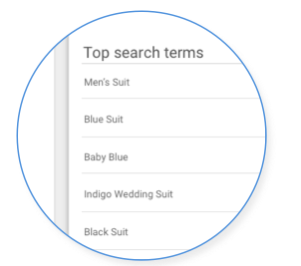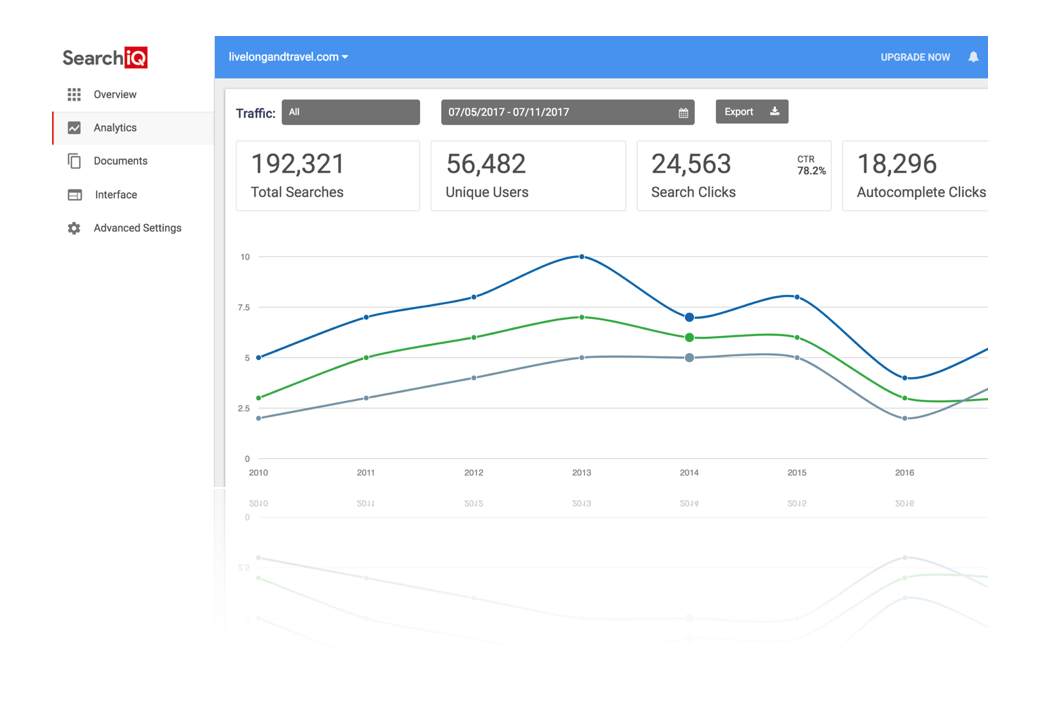Search Analytics
SaaS services have helped raise the bar for what we enjoy and now expect from the apps and sites we use every day. By leveraging specialized, managed services, delivering world-class experiences is easier than ever. Moreover, these SaaS services’ innovations enable features and functionality that were otherwise inaccessible to all but the behemoths such as Google and Amazon.
One such feature businesses can now take advantage of is Search Analytics, specifically on-site search analytics. Not to be mistaken for search engine analytics that track aggregate search activity on search engines such as Google, search analytics, in this case, refers to the analysis of search behavior on your own site.
At SearchIQ, our search analytics service empowers our customers with real-time access to a treasure-trove of insights.
“The potential value behind the queries issued by your customers is in practice unbounded. So do not waste this potential— use the knowledge behind these queries.”
– Ricardo Baeza-Yates, VP of Yahoo! Research
With our search analytics platform, we stay true to our mission of making advanced technology easy to use. We designed our search analytics platform to be both intuitive and powerful so that our customers have easy access to actionable information. To help illustrate just how search analytics can improve your business we can look at a few examples.
Product Planning
A suit manufacturer can predict trends in colors by analyzing search requests irrespective of what the current store offers. Unsurprisingly, blue is a popular color. Dig a little deeper, and it is clear that lighter colors including lighter shades of blue are more sought after than Black or Navy; the latter not even being amongst the top 5 search terms.
Successful forecasting of product characteristics like color can easily lead to numerous benefits. This includes efficiently meeting demand, maximizing profits, reduction of overages and the subsequent need for inventory liquidation that can hurt the brand.
Search Optimization
Even with insight into your customers’ wants and intentions, it can be difficult to predict exactly how users will search for your products and services.
Footsmart.com was able to improve their conversion rate for site searches by 82%, by enacting a weekly monitoring campaign of underperforming search terms and adjusting the results accordingly.
There are many complementary techniques to optimize your results at your disposal. 
- By reviewing search queries that did not lead to results you can tailor the descriptions and tags of substitute products and services to include their keywords used in the failed searches.
- With tools like synonym mapping (available with SearchIQ), you can map terms such as “slate” to results with similar colors such as “gray” and “azure”.
- If you find that users are using multiple keywords to search your products and services, a broad match filter can be a better option over phrase matching.
UX Optimization
Search analytics can identify both problems and opportunities in the UX, including your content and navigation strategy. In reviewing the top search results, you can better understand what users had to search for, ergo, what wasn’t easily accessible in your site’s navigation or content presentation.
Simply featuring your site’s most sought-after content on the homepage can lead to a dramatic increase in conversions. Moreover, it is considered best practice to actually showcase what lies beyond the homepage.
The discovery of category or other high-level pages in search results is an indicator that your site’s navigation is either poorly structured or categorized. As a general rule, search is best used for helping users quickly and easily finding specific pages and should not be a replacement for good navigation. Fortunately, SearchIQ can provide the data needed to inform your UX optimization decisions.
In summary, Search Analytics is an often under-utilized, yet highly valuable resource that captures and exposes your users intent, can drive product and service planning, help hone your product merchandising and enable data-driven UX improvements.
SearchIQ includes its analytics suite with all accounts, making the power of on-site search analytics and the business intelligence it provides access to stakeholders across your organization.

